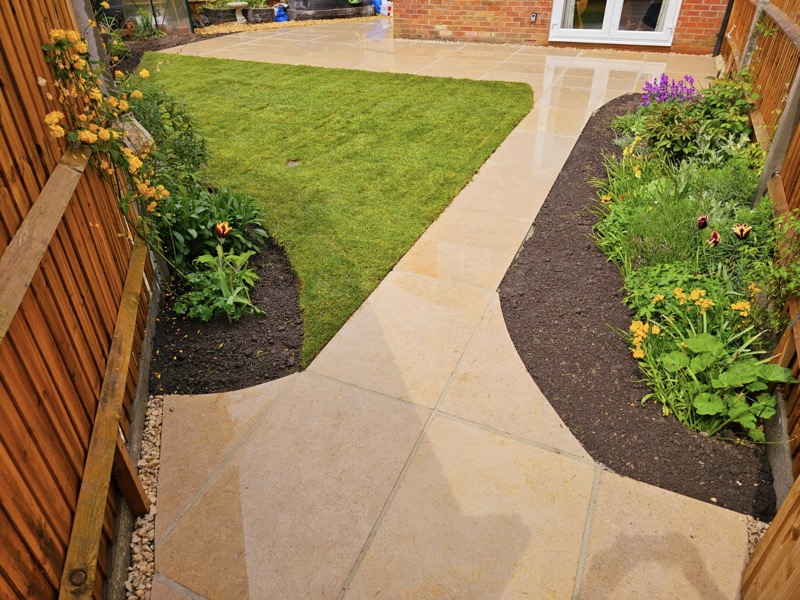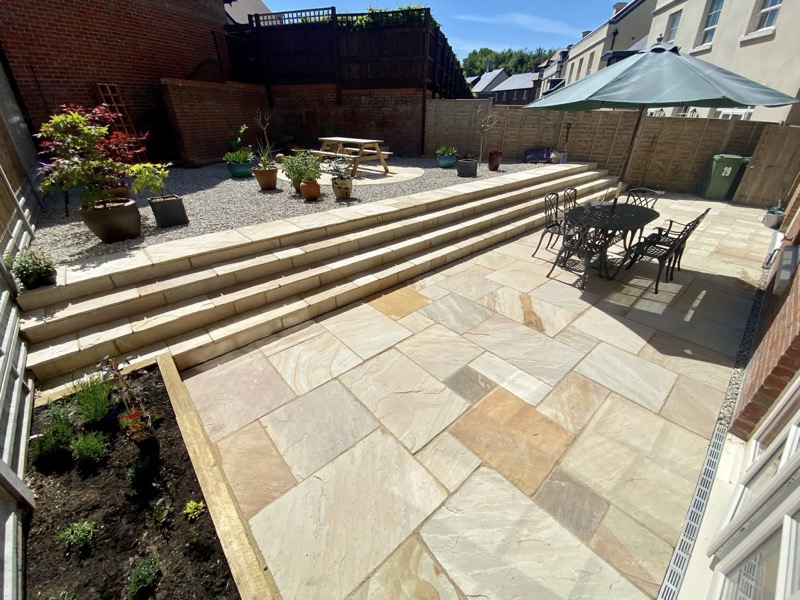In this section, we are going to look at the different characteristics of both sandstone and limestone paving and their suitability as a paving material in the UK climate. It will hopefully allow our customer to make an informed choice, when selecting their paving material and hopefully allow them to create the garden of their dreams.
Limestone Characteristics
Limestone has a great deal of different paving types within one category, each of these products have different finishes, and characteristics and comes from completely different parts of the world. These factors can affect the performance of the different limestones as well as their appearance, but in general, Limestone tends to provide a consistent colour palette, giving a more homogenous feel to the overall look of the installation.

Images above show Dijon Limestone slabs
Pros of Limestone
- Hardwearing — Limestone is quite a varied range of stones, all with very different characteristics, but generally all limestones are hardwearing especially Indian and Egyptian limestones. They are extremely dense in nature, making them extremely durable. There are softer limestones available, but these are not really suitable for external use and are best used in internal tile installations.
- Slip resistant — Limestone is a varied range of stones, all with very different characteristics which can affect their slip levels but generally these products have good slip resistance if maintained correctly. The finish of the limestone can also affect their slipperiness, smoother finishes will be more slippery and natural riven surfaces will be the least slippery, so it is important to select the correct finish for your specific situation.
- Eco-friendly — All limestones are environmentally-friendly products, they can be recycled and are biodegradable. Their manufacturing process has less damaging effects on the environment because it’s not processed with harmful chemicals and very little fossil fuels are used in the manufacturing process.
- Porosity — Limestone is a very varied group of stones all with different characteristics, but generally limestones are slightly less porous than Indian Sandstone paving, making them extremely well suited to the UK climate. The porosity level of the stone can also help with its slip resistance, as the water is less likely to sit on the surface the more porous the stone.
- Cleaning — Limestone paving can be cleaned with a pressure washer, but we would recommend firstly trying soapy water and a stiff brush. If this does not give you the desired results, then move onto a pressure washer. When cleaning with a pressure washer be careful not to get too close to the surface of the stone as this could damage the surface. After pressure washing you many need to apply an additional coat of sealant that could have been removed by the pressure washing.
- Long-lasting — You can expect all Limestone Paving Slabs to last for decades if installed and maintained correctly.
- Price point — Generally Limestone slabs are all reasonably priced, especially those sourced from India where labour costs are lower compared to some European Limestone also available.
Cons of Limestone
- Sealing — All Limestone paving slabs will need sealing directly after installation. Ensure that you use a water based impregnating sealer that will still allow the stone to breathe and allow for the natural process of efflorescence to take place. Limestone paving is naturally porous, and this must be maintained or you can cause damage to the surface of the stone. Always make sure your paving is completely dry before sealing and that you have at least 24 hours of dry weather ahead after sealing has been completed to allow the sealer to cure.
- Cleaning — Limestone paving will require some level of regular cleaning with a pressure washer, but we would recommend first trying soapy water and a stiff brush. If this does not give you the desired results, then move on to a pressure washer. After pressure washing you may need to apply an additional coat of sealant that could have been removed by the pressure washing.
- Limited colour variation — On larger paved areas it may be beneficial to have more colour variation than is provided with some limestone paving materials, as the wide colour variation can help break up the appearance and soften the over appearance of the paving. Some limestone such as Yellow Limestone has a greater colour variation but not generally as much as our range of Indian Sandstone Paving slabs.
Sandstone characteristics
Sandstone paving is a popular choice among many homeowners due to its beauty and distinctive style. Available in a range of multicoloured stones, they’re a great way of adding character to any outdoor space. With that said, there are many other advantages of choosing to install sandstone pavers.

Images above show Mint Fossil Sandstone
Pros of Sandstone
- Slip resistance — In general sandstone paving is not slippery if it is well maintained. There are a great deal of finishes available in this material, each with different natural slip resistances. The natural riven surface of hand split sandstone paving has the best slip resistance. This slip resistance reduces as the surface of the sandstone becomes smoother, such as honed or polished. Different types of Indian sandstone and their slip resistance: Riven – excellent slip resistance; Honed – average slip resistance. Polished – low slip resistance (Only possible on very hard, less porous stones). The porosity level of the stone can also help with its slip resistance, as the water is less likely to sit on the surface of more porous stones, which is a great advantage of the reasonably porous characteristics of all sandstone paving slabs.
- Long-lasting — Even if sandstone doesn’t quite match the durability of most Limestones, it’s still very strong when properly maintained and cared for. This means it can last decades once it’s installed.
- Eco-friendly — All Sandstones are environmentally-friendly products, they can be recycled and are biodegradable. Their manufacturing process has less damaging effects on the environment because it’s not processed with harmful chemicals and very few fossil fuels are used in the manufacturing process.
- Variation — Sandstone is an entirely natural product and can have great colour variation and surface texture, with each piece being completely unique, this helps deliver an authentically natural look and creates a stunning finish to any garden project.
- Low maintenance — Sandstone is reasonably low maintenance. Cleaning sandstone is extremely easy and with regular maintenance simply with a hose and stiff brush or pressure washer, the stone paving can be kept looking perfect for many years.
- Hard wearing — Indian Sandstone is an extremely hard-wearing material and makes for a perfect patio. All sandstones are sedimentary rocks that have been compressed over millions of years making them generally very resistant to wear. The best of these materials are the finer grained, more uniformed textured materials such as Raj Blend (Raj Green) and Storm Grey (Kandla Sandstone).
- Price point — generally Indian sandstone paving slabs are very competitively priced and offer great value for money.
Cons of Sandstone
- Porosity — Indian Sandstone paving like most types of natural stone paving has a degree of porosity which essentially means it is permeable. Indian sandstone paving is an excellent material for all landscaping applications from patios to driveways, however, its porosity means it does need to be sealed after installation. Always use a good quality impregnating sealant that is specifically formulated for natural stone. Without sealing Indian sandstone can start to look worse for wear after a few years and will require increased maintenance to keep it looking at its best.
- Staining — All Indian sandstone paving can be stained these stains can be more, or less, visible depending on the colour of the stone. We would always recommend sealing your stone directly after installation, cleaning up spillages immediately and keeping to a regular maintenance routine. If after a few years, you find that your sandstone has become quite heavily stained, we would recommend using a heavy-duty natural stone cleaner such as New Clean 60 from Universeal Sealants. More about removing stains check our guide to “Remove Rust Stains on Natural Stone“
- Discolouration — Indian sandstone as with all natural stones is susceptible to discolouration and damage from acid rain. This is an unavoidable realty of living in the modern world, but these effects will take quite some considerable time, normally many decades, to manifest themselves as damage on your patio surface. There is very little point worrying about this, as there is nothing that can be done to avoid it. We would always recommend regularly sealing and undertaking regular maintenance of your paving, to minimise these effects and to keep it looking good for as long as possible.
- Scratches — As mentioned above, sandstone is softer than other types of rock. This means it can be more prone to dents and scratches over time. However, if properly cared for this shouldn’t be too much of an issue.
Conclusion
As you can see from the pros and cons above, both materials are perfect materials for your garden paving but there are a number of advantages and disadvantages of using both Sandstone and Limestone paving, they are both excellent paving materials, both materials are extremely durable, reasonably low maintenance, and both can withstand the UK climate perfectly.
While sandstone does absorb a bit more water than limestone, both are relatively water-resistant, so with regular maintenance, you don’t need to worry about rain affecting the appearance of either material.
If you are looking for a product with a good deal of colour variation I would say you should lean towards the more colourful sandstone paving slabs such as Rippon Buff and Raj Blend, if you looking for a more consistent colour pallet, it would be worth considering limestone paving as your first port of call.
Limestone may be the slightly better option when it comes to longevity and maintenance as some of the lighter shades of sandstone such as Mint Fossil may require a little extra cleaning or sealant application. While this difference is minimal, it may be a contributing factor, especially if you are looking for minimal maintenance.

